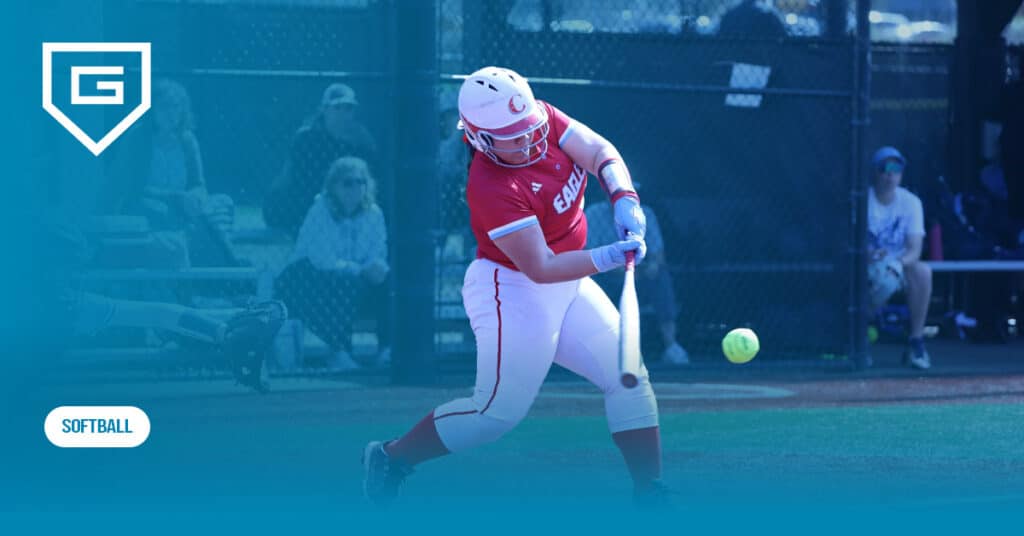10 Must-Do Softball Drills to Dominate the Field
Reading Time: 11 minutes
Reading Time: 11 minutes
Mastering the fundamentals of fastpitch softball requires a combination of effective softball drills and cutting-edge coaching tools.
Integrating softball drills with sports coaching technology, like GoRout’s advanced communication system, streamlines practice sessions, enhances player performance and prepares your team for game day.
In this article, we will explore ten softball drills to help your team dominate the field this season and discuss how you can implement GoRout to boost your team’s results.
The Fundamentals of Effective Softball Drills

Softball coaching involves incorporating various drills—such as live base running, throwing, and hitting drills—into fastpitch softball practice plans. Effective softball drills are essential for coaches to help players optimize individual skills and improve team performance during the season.
Key components of a successful drill
Key components of a successful softball drill include clear objectives, realistic scenarios and consistent feedback. You should add these drills to practice plans to address skills like batting, fielding and base running. Make sure players understand the purpose and goals of each exercise.
Balancing team needs with individual player development
Team softball drills foster communication and cohesion. Individual drills allow players to focus on their unique strengths and areas for improvement. Coaches should tailor drills to challenge each player appropriately to promote personal growth without neglecting the collective progress of the team.
Time management during softball practice sessions
Effective practices allow a short period for warm-ups, skill-specific drills and game-like scenarios. Coaches should maximize efficiency with each minute contributing to player development and preparing teams for the next game.
Top 10 Softball Drills to Improve Team Performance

From outfield drills to live batting practice, these are the top 10 softball drills to add to your practice plan.
Drill #1: Dynamic Warm-Ups for Agility
Dynamic warm-ups prepare young players’ bodies for the physical demands of softball and reduce the risk of injury.
Importance of a proper warm-up
A proper warm-up increases blood flow, strengthens flexibility and primes the nervous system for the intense movements required during softball practice. Warming up helps prevent injuries and prepares players to perform at their best mentally and physically.
Examples of dynamic warm-up drills
- High knees
- Butt kicks
- Leg swings
- Lunges with a twist
- Arm circles
Drill #2: Hitting for Power and Precision

Hitting drills develop power and precision – two critical components of successful softball batting.
Techniques to enhance batting strength
- Proper stance and grip: Create a balanced stance and firm grip on the bat
- Hip rotation: Focus on powerful hip rotation to generate force
- Follow-through: Emphasize a complete follow-through for maximum power
Drills to improve hand-eye coordination
- Tee work: Practice hitting from a tee to focus on swing mechanics
- Soft toss: Use underhand throws for timing and contact
- Batting cage: Face various pitch speeds and types to strengthen reaction time
- Small ball drill: Hit smaller balls to sharpen focus and precision
Drill #3: Base Running Tactics
Base running tactics maximize scoring opportunities and put pressure on the opposing defense.
Increasing speed and efficiency on the bases
Sprints and interval training improve running speed and endurance for quick and agile players. Developing first-step quickness through explosive start drills helps gain an advantage when stealing bases or advancing around the basepaths.
Strategic softball drills for base stealing
- Lead-off drills: Practice taking the optimal lead-off distance and reacting quickly to pitchers’ movements
- Reaction drills: Use various signals and timing exercises to improve players’ reaction times and decision-making skills
- Sliding drills: Teach proper sliding techniques to avoid tags and maintain speed
- Live game simulations: Conduct scrimmages focusing on base stealing scenarios to apply in game-like conditions
Drill #4: Defensive Skills for Infielders and Outfielders
Using outfield drills to develop strong defensive skills prevents runs and secures outs to win softball games.
Infield softball drills for quick reflexes
- Ground ball drills: Practice fielding ground balls hit at various speeds and angles to improve reaction time and glove work
- Rapid fire drills: Use a machine or fungo to hit a series of quick, consecutive ground balls for better reflexes and decision-making under pressure
- Footwork drills: Focus on proper foot positioning and quick movements, smooth fielding, and throwing transitions
- Tag drills: Apply quick and accurate tags on runners attempting to steal bases or advance
Outfield softball drills for maximum range coverage
- Drop step drills: Practice the drop step technique with your lead foot to quickly get into position for catching deep fly balls
- Fly ball outfield drills: Hit repetitive fly balls to improve tracking, catching and throwing
- Relay drills: Develop coordination between outfielders and infielders for relay throws that you will need in-game
- Gap coverage outfield drill: Train outfielders to cover gaps and back each other up to prevent extra bases on a drop
Drill #5: Pitcher’s Power Circle
Pitching drills build stamina and control for pitchers to maintain peak performance throughout a game.
Building stamina and control for pitchers
Pitchers should sustain their strength and accuracy from the first pitch to the last. To increase their endurance, they should incorporate long-distance running and interval training into their routine. Bullpen sessions focused on hitting specific targets and practicing different pitch sequences under simulated game conditions help pitchers refine their pitches.
Drills to enhance pitching velocity and accuracy
- Long toss drills: Improve arm strength and throwing mechanics by increasing throwing distance
- Bullpen sessions: Focus on accuracy and control by pitching to locations within the strike zone
- Resistance band workouts: Build shoulder and arm strength to increase velocity
- Pitch sequence drills: Simulate game situations to practice mixing pitches and maintaining control
Drill #6: Catcher’s Corner

Catcher drills focus on effectively managing the game, preventing stolen bases and supporting pitchers.
Blocking and framing techniques
Blocking drills teach players how to position their bodies to block pitches in the dirt. Practicing framing techniques helps catchers adjust their glove position to increase the likelihood of strike calls.
Throw-down drills to second and third base
- Quick release drill: Focus on rapidly transitioning from receiving the pitch to throwing
- Footwork drill: Practice proper foot positioning and movements for efficient, accurate throws
- Target practice: Set up second and third base targets to improve throwing accuracy
- Pop time drill: Measure and aim to reduce the time from glove to glove
Drill #7: Team Coordination and On-Field Communication
Communication drills help coaches and players convey information quickly and cultivate trust and camaraderie with their teammates.
You can use the GoRout coach-to-player communication system to improve team coordination by streamlining signals and instructions to players in real-time.
Establishing effective on-field signals
Players learn and refine a set of signals and verbal calls to communicate plays, defensive alignments and strategic adjustments without alerting opponents.
Role-specific communication strategies
Different positions require GoRout’s position-specific messaging of strategies, relaying defensive alignments, cutoffs or coordinating double plays tailored to their responsibilities on the field.
Collaboration exercises between players
- Relay throw drill
- Rundown drill
- Double play drill
- Defensive shift drill
Drill #8: Situational Awareness Scenarios
Game situation drills help players make quick, informed decisions under pressure.
Simulating game-like conditions
Simulating game-like conditions in practice drills, such as pressure-packed moments with bases loaded or late-game run-saving scenarios, helps players develop the skills to succeed under pressure.
These drills aim to mimic the intensity and unpredictability of game situations to practice executing strategies. Making split-second decisions and maintaining composure when the game is on the line is crucial to winning.
Decision-making drills under pressure
- Bases loaded, two outs
- Runner on third, less than two outs
- Extra-innings
- Game-winning hit drill
Drill #9: Building Mental Toughness and Focus
Building mental toughness and focus allows softball players to perform consistently under pressure and maintain composure during intense game situations.
Mental conditioning drills
- Visualization exercises: Players visualize themselves successfully executing plays or hitting in clutch situations
- Breathing techniques: Teach players to control their breathing to manage stress and maintain focus
- Positive self-talk: Encourage players to use positive affirmations to boost confidence
Concentration exercises for high-pressure situations
- Focus on the present
- Stay task-oriented
- Practice mindfulness
Drill #10: Endurance and Stamina Softball Practice

Endurance and stamina allow softball players to maintain peak performance throughout the game.
Cardiovascular drills for softball players
- Interval sprints: Alternate between short bursts of maximum effort sprints and brief periods of rest
- Shuttle runs: Perform shuttle runs, moving quickly between designated points
- Circuit training: Incorporate jumping jacks, burpees and mountain climbers into a circuit format
- Agility ladder drills: Use agility ladders to improve footwork, coordination and cardio conditioning
Long-distance running vs. sprint intervals
Long-distance running builds aerobic endurance so players sustain performance throughout a game and develop mental toughness. Sprint intervals improve anaerobic capacity and speed to make quick bursts of explosive movements on the field – sprinting to bases or chasing down fly balls.
Customizing Drills for Different Age Groups and Skill Levels
Customizing softball drills for athletes of different ages and skill levels ensures that all players receive appropriate challenges and developmental opportunities.
Adjusting softball drills for youth teams
Drills for youth teams with younger players should focus on fundamental skills, show kids basic techniques and foster a love for the game. Drills should be simple, engaging and fun to keep young players motivated. Use games and activities that have kids incorporate basic batting, throwing and catching skills.
Scaling softball drills for advanced players
Scaling drills for advanced players require more complex and intense drills to refine skills and improve tactical understanding. Drills in an advanced practice plan include more sophisticated hitting techniques, complex defensive plays and situational practice that mimics real-game scenarios.
Incorporating Technology and Modern Coaching Tools
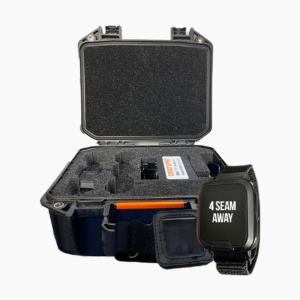
The integration of wearable technology in sports has transformed how players receive instructions and how coaches manage strategies on the field. GoRout is leading trends in sports providing a platform that streamlines communication between coaches and players to intensify softball drills in practice and help teams win games.
What is GoRout Diamond?
GoRout Diamond is a cutting-edge softball coaching tool. Its streamlined pitch-calling system enhances communication between coaches in the dugout and players on the field.
Coaches use GoRout Diamond to customize pitch calls, defensive strategies and offensive plays. This innovative fastpitch softball technology replaces traditional hand signals to reduce confusion, increase privacy and improve efficiency during softball practices and games.
Get a quote now.
How GoRout Diamond works
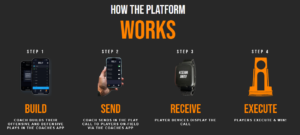
GoRout works in a few simple steps. Coaches build offensive and defensive plays in the coaches app. They send the play call to players on the field. The player devices receive the call, and players use proper mechanics to execute the call and win the game!
GoRout equipment includes a customized number of on-field player units, on-field belts, cloth bands and a robust “Stow & Go” charging station. Users can access GoRout Air™ and a 100% full-coverage warranty for added peace of mind.
On-field player device
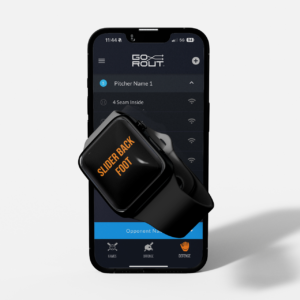
The GoRout player device pack comes ready straight out of the box, requiring no setup, pairing or programming. The wristbands are fully encrypted for full speed and immediate use in games and practices, even without Wi-Fi. Players can effortlessly select their position, promptly receive position-specific messages, and play calls for quick game speed.
On-field coaches app
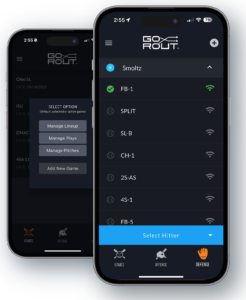
The on-field coaches’ app is a user-friendly, powerful application designed to streamline softball coaching tasks. Coaches create pitch calls, set defensive hitter shifts and design offensive play calls with just a few touches to practice a drill properly or improve a practice plan.
The app allows coaches to create new games, organize pitch groups and send specific pitch calls directly to player devices on the field.
Experience the app here to witness how it elevates softball teams’ skill level, batting practice and softball drills.
How GoRout Diamond improves team communication and performance
GoRout Diamond’s electronic pitch-calling system improves team communication and performance through its customizable coaching technology.
Coaches can easily build plays and pitch calls and send them to players in real-time, ensuring prompt receipt and execution. Real-time communication makes for quick adjustments and coordinated strategies tailored to individual player strengths and game situations.
Coaches can create personalized strategies with the ability to input individual pitch repertoires, defensive shifts, opponent lineups and position-specific messages.
Integrating the system into practice sessions promotes teamwork and enhances decision-making, leading to improved softball drills, leading performance and reduced errors during games.
8 reasons to implement GoRout Diamond in softball coaching
Implementing the GoRout pitch calling device into your fastpitch softball coaching routine offers several advantages:
- Enhanced pitch calling: GoRout simplifies pitch calling with streamlined coach-to-player communication that eliminates concerns about sign stealing and quickens game speed.
- Streamlined team communication: This reliable system gives teams a safe way to communicate, teaching players to execute their practice plans during games.
- Weather resilience: GoRout wristband devices are designed to withstand various weather conditions, including rain, extreme heat, humidity or snow.
- Adaptive display: Featuring light and dark modes, the screen is easily visible in different conditions – sunny or rainy days, night games or overcast environments.
- NCAA approval: GoRout Diamond is one of the few wearable technologies compliant with NCAA rules for use in college games.
- Secure communication: All GoRout devices come with four-way privacy screens. Pitch calls are encrypted to ensure secure transmission between coaches and players.
- Coach-approved: Developed and approved by fellow softball coaches, GoRout instills confidence in its users by providing a simple yet effective experience for softball teams.
- Comprehensive warranty: GoRout offers peace of mind with a full coverage warranty that protects against device problems, breakage or defects.
Check out these GoRout testimonials from coaches who used GoRout softball to improve practice plans and win games.
Measuring Progress and Success of Softball Drills

Fastpitch softball coaches measure the progress and success of their softball drills by setting goals and using performance data to enhance practices.
Setting benchmarks and goals
Coaches should establish clear, measurable goals for individual players and the team. These benchmarks include specific skill improvements – increased batting averages, improved fielding percentages or faster base-running times. Set short-term and long-term goals to keep players motivated and focused.
Using data to inform future practices
Softball coaches collect data by tracking performance metrics, recording practice sessions and using catchers wristband system like GoRout to monitor real-time performance. Analyzing data identifies strengths, weaknesses and trends in player performance. If, for example, data reveals that players are struggling with one type of pitch, coaches can adjust drills to include more live batting practice.
Common Mistakes to Avoid in Softball Drills

When conducting softball drills, there are a few important points to avoid that hinder player development and team performance.
Overtraining and burnout
One of the most detrimental mistakes is pushing players too hard, leading to physical and mental exhaustion. Overtraining can result in injuries, decreased performance and a loss of enthusiasm for the game.To avoid burnout, balance intense training sessions with adequate rest and recovery periods.
Neglecting player feedback and adjustment
Fastpitch softball coaches should actively seek and listen to player input regarding drills and practice plans. Neglecting this feedback leads to frustration and disengagement. Regularly adjust drills based on player responses to make practices effective and enjoyable.
Failing to create a positive and supportive learning environment
Coaches who focus solely on performance and results without a positive team culture create an environment of stress and anxiety. Encourage teamwork, celebrate improvements and maintain a supportive attitude to build confidence and resilience in players.
Conclusion
Incorporating these ten must-do softball drills into your practice plan can boost your team’s performance and help fastpitch softball players dominate the field.
Focus on key player skills and position strategies, so players develop their abilities and work more cohesively as a unit.
Innovative tools like the GoRout pitch calling system streamline communication, so coaches and players are always on the same page and ready to excel every season.
Get a quote to see how GoRout Diamond can intensify your softball drills and get your team playing their best.
FAQs about Softball Drills
How can I make softball practice fun?
To make softball practice fun, incorporate games, friendly competitions and creative drills to keep players engaged and excited. Use music and positive reinforcement and end with enjoyable activities to create a lively and motivating atmosphere.
What is the 21-out drill in softball?
The 21-out drill in softball involves simulating game-like scenarios where the defensive team must record 21 consecutive outs without errors or mistakes. The coach hits balls randomly across the field for the drill. Fly balls, ground balls and varietal baserunners are used to simulate an array of game-like scenarios in the drill.
What drills do you do for softball hitting?
Some good softball hitting drills to include in your practice plans are half turns, the see-saw drill, the bat path drill and slow-to-fast.





